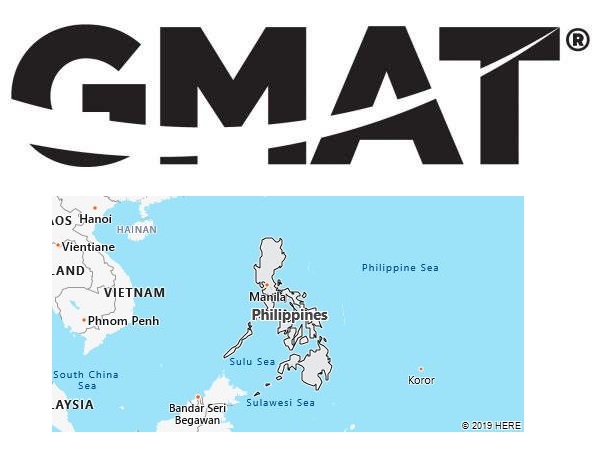GMAT Testing Locations
We have found 2 GMAT test centres in Philippines, located in Cebu City and Manila. For specific test dates of 2019, please refer to the end of this page.

#1. MISNet Education Inc. – Cebu City
Unit 401 Don A.Gothong Centre (Sugbutel)
Sergio Osmeña Boulevard
North Reclamation Area
6000 Cebu City
Philippines
Phone: +63 32 2311618
Test Center Information
From SM City Mall take the jeepney route (12J / 12I / 12E) and alight in front of Don Alfredo Gothong Centre (also known as Sugbutel Hotel building) which is along the road Sergio Osmeña Blvd in North Reclamation Area. If coming from South take any jeepney route going to SM City, and after you pass by Robinsons Galleria, Cokaliong, PCSO Building, alight in Pier 5 and cross the road going to Sugbutel. If riding a cab/taxi just instruct the driver to drop you off at Sugbutel Hotel as we are on the same building.
#2. MISNet Education Inc
Unit 2201 Antel Corporate 2000 Centre
121 Valero Street
Salcedo Village
1227 Makati City Manila
Philippines
Phone: 63 2 846-8307
Test Center Information
From Ayala Avenue, Makati City you will see PBCOM Tower.Turn right to Herrera Avenue. After 25 meters turn right to Valero street. Then after 30 meters turn right, again. You will see the Antel 2000 Corporate Centre.
Landmark:
UCPB Bank
Ministop Convenience store
We are also infront of Valero Tower (Shakeys)
GMAT Exam Dates in Philippines
Unlike some paper based exams, the GMAT is computer based. Therefore, there are no fixed test dates for GMAT. Wherever you are in Philippines, all test centers are open from Monday through Saturday throughout the year. Some even offer the exam every day of the year. However, some test centers are not open on Sundays and national holidays. For example, most college-based test centers might be closed for extended periods around holidays. For precise testing dates in Philippines, please visit test-maker website – https://www.mba.com/.
More about Philippines
Philippines, official name: Filipino (Tagalog) Republika ñg Pilipinas [- ŋ g], English Republic of the Philippines [r ɪ p ʌ bl ɪ k əv də f ɪ l ɪ pi ː nz], German Republic of the Philippines, State and archipelago in Southeast Asia, in the western Pacific, between the Philippine Sea and the South China Sea with (2018) 106.7 million residents; The capital is Manila.
Population
Ethnically and linguistically, the population (Filipinos) comprises more than 50 groups (Ifugao, Kalinga, Lumad, Mangyan, Moro, Tagalen, Tausug, Visaya and others).
The historically oldest residents, the Aeta, number only around 70,000 people; they were partially displaced from their original habitat. Of the immigrants in the last few centuries, the Chinese and the mixed race of Chinese origin (10% of the population) play a significant role in the economy as a largely integrated but coherent group. The ethnic diversity is also reflected in the linguistic diversity of the country. The language of the Tagalen, the Tagalog (since 1987 Filipino) modified by borrowing from other Filipino languages and American English, has been the official language of the Philippines in its standardized form since 1946.
With an average (2017) 352 residents / km 2, the Philippines are very densely populated. Over 90% of the population live on the largest islands. The main areas of settlement are the plains of the two main islands, Luzon and Mindanao, while the mountain regions are only sparsely populated. Around one in four lives in the greater Manila area and the regions bordering on the north and south of the region, which are well developed in terms of infrastructure. Overall, the share of the urban population (2017) is 44%. Around 10 million Filipino nationals live as migrant workers abroad (mainly in the USA and in the Near and Middle East).
The most serious development problem is the rapid population growth since the end of the Second World War: between 1948 and 2016, the population rose from 19.2 million to 103.3 million.
The largest metropolitan areas in the Philippines
| Largest metropolitan areas (pop. 2015) | |
| Manila | 23 371 400 |
| Cebu | 2,476,700 |
| Davao | 1 439 600 |
| Angeles | 1,332,900 |
| Cagayan de Oro | 716 100 |
Religion
The constitution (Article 3) guarantees religious freedom and expressly excludes the establishment of a state religion. Traditionally, however, the Roman Catholic Church occupies a prominent position in public life: According to the latest available surveys, over 80% of the population belong to it. In addition, there is just under 1% of the population who join the Philippine Independent Church (“Iglesia Filipina Independiente”, founded in 1902 as a Catholic national church independent of Rome, since 1965 associated with the Old Catholics ; Roman-free Catholic churches) confesses. Around 9–11% belong to a large number of (post-) Reformation denominations (Baptists, Reformed, Methodists, etc.), the Anglican Church (“Episcopal Church in the Philippines”) and various independent Philippine churches, including the non-Trinitarian “Iglesia ni Cristo «(founded in 1914, about 2.5% of the population) occupies a special position. Other religious groups related to Christianity are the Mormons and Jehovah’s Witnesses.
More than 5% of the population (especially the Moro) are Muslims, the majority of them Sunnis from the Shafiite school of law. There are also Baha’is and Buddhists as well as followers of traditional religions. Up to 4% of the population have no religious affiliation.
